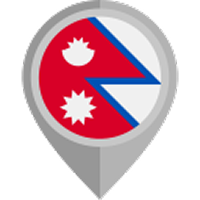Nepal vision | 23/10/2023
Trekking in Nepal isn't just about walking through stunning mountain scenery; it's a journey through cultures, traditions, and unforgettable experiences. Moreover, it has a handful of options for highest altitude treks in Nepal.
The higher you go, the more spectacular the scenery and the more challenging the journey becomes.
Likewise, the altitude can have a significant impact on your body. It is crucial to understand and respect its role in your trekking adventure.
In this guide, you will explore some of the best high-altitude treks in Nepal to make your adventure memorable and safe.
Top High Altitude Treks in Nepal
Nepal offers several high-altitude treks that promise breathtaking scenery and an adventure of a lifetime. Let’s break down some of the top high-altitude treks in Nepal.
Everest Base Camp
The Everest Base Camp Trek is a renowned Himalayan adventure. The journey takes you through the heart of the Khumbu region in Nepal. The route starts in Lukla, where you'll fly in, and then involves a trek through stunning landscapes.
You'll pass through Sherpa villages like Namche Bazaar, enjoy breathtaking mountain views, and visit the Everest Base Camp. The highest point is Kala Patthar, which offers a stunning view of Mount Everest.

The Everest Region trek is challenging due to the high altitude, with elevations ranging from 2,800 meters in Lukla to over 5,500 meters at Kala Patthar, so acclimatization is crucial.
Annapurna Base Camp
The Annapurna Circuit Trek in Nepal is a renowned journey for trekkers seeking diverse landscapes and cultural experiences. It offers a 100-200 mile route (depending on variations) that circles the Annapurna Massif. Starting in lush subtropical terrain, it gradually ascends to the arid Trans-Himalayan region of Manang and Mustang.

Along the way, you encounter diverse ethnic villages, beautiful forests, and mesmerizing mountain views, including the formidable Annapurna peaks.
It's a challenging trek due to its altitude and duration, but the rewards are stunning panoramas and a deep immersion in Nepalese culture.
The Thorong La Pass, at 17,769 feet, is a challenging but gratifying high point.
Manaslu Circuit Trek
The Manaslu Circuit Trek is a challenging yet enriching adventure in Nepal. It offers a genuine wilderness experience with stunning mountain vistas. You'll trek around Manaslu, the eighth-highest mountain globally, passing through remote villages and lush forests.
The trail is less crowded than some other Nepal treks, providing tranquility and immersion in nature. You'll encounter diverse cultures, from Hindu lowlands to Tibetan-influenced highlands.

Meanwhile, the challenging terrain and high altitudes make it essential to be well-prepared. However, the unique landscapes and cultural experiences make it a memorable journey for those seeking a less crowded trek in the Himalayas.
Makalu Base Camp Trek
The Makalu Base Camp Trek is a challenging yet rewarding journey in the eastern Himalayas of Nepal. This trek offers stunning, unspoiled natural beauty and a sense of isolation as it's less crowded than some popular routes.
You'll traverse diverse landscapes, from lush forests to rugged terrains, culminating at Makalu Base Camp. You will be treated to breathtaking views of Makalu, the world's fifth-highest peak. It's a physically demanding trek due to the altitude and the steep, remote paths.

However, the sense of accomplishment and the chance to experience the raw, untouched beauty of the Himalayas make it an unforgettable adventure for those seeking a unique trekking experience.
Upper Dolpo Trek
The Upper Dolpo Trek takes you on an incredible journey to one of Nepal's most remote and least-visited regions. Located in the far west of Nepal, this trek offers a raw and untouched experience.
You'll encounter dramatic landscapes, ancient Tibetan culture, and the beauty of Shey Phoksundo National Park. The trek begins in Juphal and leads you through rugged terrains, high mountain passes, and picturesque villages.

Likewise, you'll have the chance to explore Shey Gompa, a centuries-old monastery, and cross the challenging Kang La Pass. The highlight of the trek is Phoksundo Lake, a stunning cobalt-blue lake that seems almost surreal in its beauty.
Gosaikunda Trek
The Gosaikunda Trek is famous and relatively shorter in Nepal, known for its spiritual significance and picturesque mountain views.
The trek takes you to the sacred Gosaikunda Lake, which is believed to be the abode of Lord Shiva. From Kathmandu, the trail passes through lush forests, charming villages, and alpine meadows.
Along the way, you'll come across various high-altitude lakes, with Gosaikunda being the most revered. The view of the Langtang Himalayan range adds to the trek's allure.

Gosaikunda is accessible and offers cultural and spiritual encounters amidst breathtaking natural beauty.
Valuable Tips for High Altitude Treks
Packing and gear maintenance
When preparing for a high-altitude trek, packing efficiently is crucial. Keep your backpack light. But ensure you have essentials like warm clothing, a good quality sleeping bag, and sturdy, broken-in hiking boots.
Regularly check your gear for wear and tear, and carry emergency repair kits. It's a balance between staying light and staying prepared.
Hydration and nutrition
Staying hydrated is vital at high altitudes, as it helps combat altitude sickness. Drink plenty of water and avoid excessive caffeine and alcohol.
As for food, high-carb and high-calorie meals provide energy for the strenuous trek. For quick boosts, carry snacks like nuts, energy bars, and dried fruits. Remember to acclimatize to the altitude, so take it slow.
Managing waste responsibly
Leave no trace. Pack out everything you bring in. High-altitude regions are ecologically fragile. Dispose of waste in designated areas and respect the local environment. Use eco-friendly soap and bring reusable water bottles and bags to minimize waste.
Trekking in different seasons
The timing of your trek matters. Spring and autumn are the most popular seasons due to favorable weather. However, be prepared for variable conditions.
High-altitude treks can be challenging in winter due to extreme cold, and the monsoon season brings heavy rains. Plan according to your comfort level and the experience you seek.
Conclusion
Successful high-altitude treks in Nepal require careful preparation, focusing on packing essentials, staying hydrated, respecting the environment, and choosing the right season. You should follow these guidelines and enjoy the stunning beauty of the Himalayas. Nepal Vision Treks offers a practical trekking experience while ensuring your safety and well-being.
FAQS
1) How long does it take to acclimatize to high altitudes?
Acclimatization typically takes 1-3 days at each significant altitude gain.
2) What's the best time for high-altitude treks in Nepal?
Spring (March to May) and autumn (September to November) offer the best weather and views.
3) Is bottled water available on high-altitude treks?
Yes, bottled water is available, but it can be expensive; water purification methods are eco-friendly and cost-effective.
4) What's the maximum weight for a porter in Nepal?
Porters usually carry up to 20-25 kg of weight.
5) Is it safe to trek during the monsoon season?
Trekking in monsoon season (June to August) is possible, but expect heavy rain and trail difficulties.
6) Can I trek without a guide in Nepal?
Independent trekking is allowed in many areas, but having a guide enhances safety and navigation, especially in high-altitude regions.
7) How do I deal with limited oxygen at high altitudes?
Slow, steady hiking, proper acclimatization, and staying hydrated help combat altitude-related issues.
8) What kind of wildlife encounters can I expect?
In remote areas, you might spot Himalayan tahr, yaks, various bird species, and elusive snow leopards.
9) Are high-altitude treks suitable for children or seniors?
While some treks are family-friendly, most high-altitude tours are physically demanding and not recommended for very young or elderly hikers.
10) Can I use credit cards in remote high-altitude regions?
Credit cards are rarely accepted in remote areas; they carry enough cash in Nepalese rupees for expenses.









